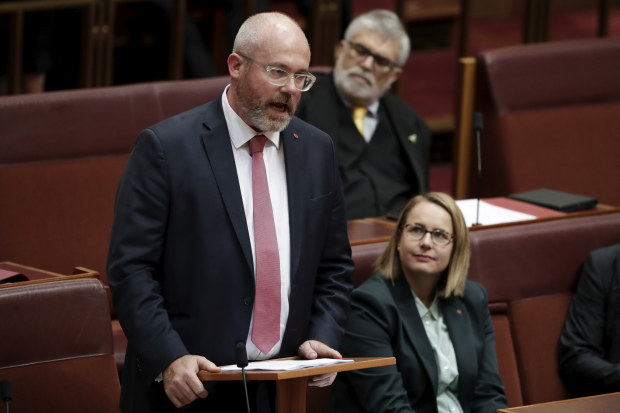Labor backs UK-style consulting hub for top bureaucrats
An internal consulting hub would help stem the loss of federal public sector capability, save money and promote “frank and fearless” advice, according to a new report from a Labor-dominated Senate committee.
The majority of the Finance and Public Administration References committee called for a formal cap on agencies to limit the amount of consulting, a ban on the use of consultants for strategic work, and the removal of Australian Public Service head count limits.
Former AMWU chief and Labor senator Tim Ayres described consultants as “rent seekers” and “ticket clippers” who had contributed to the politicisation of the public service. Alex Ellinghausen
It also called for the completion of an audit of ICT contractors by the Digital Transformation Agency. The committee report cited statistics that showed across the 77 agencies for which data was provided there were 10,184 ICT contractors compared to about 10,020 for internal public servant ICT staff.
The minority rejected the recommendations, claiming they represented “little more than a wish list for the union movement, which represents a minority of the APS workforce and only a fraction of Australian taxpayers who fund the public service”.
“Many recommendations have been lifted directly from union submissions and have ignored the evidence provided by APS agencies to the inquiry,” Tasmanian Liberal senator and deputy chair Claire Chandler said.
Citing research from the Australian Institute, the senate report titled “APS Inc” claimed the Australian consulting industry was the fourth largest in the world.
“The report describes an industry of outsourcing and sleazy Canberra deals. It’s an industry that reaps billions of taxpayer dollars and hides its profits in offshore bank accounts but delivers an inferior service for taxpayers and undermines public sector capability,” the committee chairman Senator Tim Ayres said.
“It’s an industry that relies upon opaque contracts and no accountability to the Australian public or to the Parliament. It’s an industry that redirects taxpayer money that should serve the public interest and hands it to rent-seekers and ticket clippers.”
Senator Ayres was previously the state secretary of the left-aligned Australian Manufacturing Workers’ Union.
He said Labor would decide which of the proposals it would pick up ahead of the upcoming election.
“We’re pointing to the same problems. We’ve got to get the public service leadership back to its core responsibilities,” he said.
Senator Ayres said the hub was an innovative idea based on the UK Government Consulting Hub.
“It’s the Boris Johnson model in the United Kingdom, and means that a consultancy hub would be where some of the best and brightest policy experts, graduates and practitioners from the public service would go to and provide an alternative source of policy consultancies.”
He said in the UK the hub also provided “strategic over-the-shoulder” advice for departmental secretaries and agency heads.
Under the proposal, the hub would also vet consulting contracts, with a power to rewrite contracts with consultants.
The report was scathing about the amount of consulting work the federal government undertook.
“It is utterly unacceptable that the government paid close to $1.2 billion in one year to eight private consulting firms in an entirely unaccountable way, for work that arguably should have been completed in-house by the APS,” the report says.
This, it says, was the equivalent of 12,346 full-time public service jobs.
The Thodey Review of the federal public service found widespread loss of policy capability but said it was not clear if the use of consultants had been a primary driver. It noted the lack of good data made it difficult to assess how many core functions were being outsourced to consultants.
The committee zeroed in on the tax status of many of the major tech vendors and consultancies.
“The committee is concerned that domestic companies that abide by Australian tax law are at a significant disadvantage in obtaining federal ICT contracts, while multinational competitors undercut them by minimising tax obligations and other corporate responsibilities.
“The fact that $4.4 billion in federal contracts was awarded nearly entirely to overseas companies in 2020 alone highlights the extent of this problem.
“The committee feels strongly that multinational companies that engage in tax minimisation in Australia should not be rewarded with taxpayer money through large federal ICT contracts for the APS.
“The committee recommends that where ICT contracts must be awarded to multinational corporations, at a minimum, the Australian government must require those corporations to produce a copy of reporting under the Global Reporting Initiative Tax Standard, or implement the standard within one year.”
She was legendary, and she was a legendary drunk, though she claimed her family’s stout was undrinkable. Perhaps you know her as the heiress to the Guinness fortune, or for her high-profile marriages, first to the artist Lucian Freud, who painted her famous 1952 portrait, “Girl in Bed.” Her third husband, poet Robert Lowell, described her as “a mermaid who dines upon the bones of her winded lovers”. Lady Caroline Blackwood was not your average socialite. A macabre, witty, and original novelist, she broached very un-ladylike subjects such as suicide, rape and dished on the eccentricities and sufferings of her own aristocratic class
The Question Is, Which Actress Should Play Lady Caroline Blackwood In A Hollywood Biopic?
Your children are not your children. They are the sons and daughters of Life’s longing for itself,” Kahlil Gibran wrote in his poignant verse on parenting. And yet we are, each of us, someone’s child — physiologically or psychologically or both — and they sing themselves through us as we sing ourselves into our longing for life, whether we like the melody or not.
How they Kick off the Christmas Season at this little Town in Italy
Going behind your back
Carter and Goldfinger explain the County of London Plan, at A London Inheritance from 1945 / illustrations by Vorja Sánchez / art and installations by Antti Laitinen / Arquitectura libre, a project that ‘focuses primarily on the architecture of remittances; the fantastical houses being built by financing from Mexican immigrants in the US who send money home’ / what’s the point of the Lego Titanic? Except for 9090 pieces. See also, the rise of the ‘kidult’ Christmas list / The McMansion Hell Yearbook reaches 1981. It’s a doozy / sort of related, Secret Bases / when Pininfarinabuilt six Ferraris for the Sultan of Brunei’s awful brother. Without telling Ferrari / in memory of designer Bob Gill / seen everywhere, but worth your while: Jurassic Park with a cat / why is this interesting? The Taylor’s Version Edition. On music, rights, and re-recording. See Taylor Swift – All Too Well: The Short Film / the Tesla Death Ray (remember the Tesla flamethrower?) / minimalist games and interactions by Hakim El Hattab / photography by Catherine Hyland / The Family Museum, a research project based around a ‘collection of around 25,000 original British amateur family photographs and 300 photo albums, dating from the 1850s to the noughties.’ Some of the collection can be seen on the Family Museum Blog.



